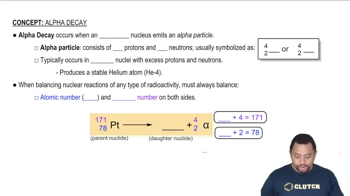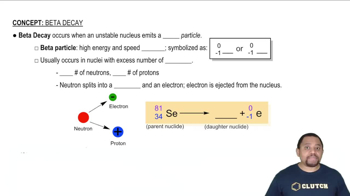Here are the essential concepts you must grasp in order to answer the question correctly.
Radioactive Decay
Radioactive decay is a process by which an unstable atomic nucleus loses energy by emitting radiation. This can occur in various forms, including alpha particles, beta particles, and gamma rays. Understanding the type of decay is crucial for predicting the particles produced during the reaction.
Recommended video:
Rate of Radioactive Decay
Alpha Decay
Alpha decay is a type of radioactive decay in which an atomic nucleus emits an alpha particle, consisting of two protons and two neutrons (essentially a helium nucleus). This process decreases the atomic number of the original element by two, resulting in the formation of a new element. Recognizing this helps in identifying the products of decay reactions.
Recommended video:
Beta Decay
Beta decay involves the transformation of a neutron into a proton (or vice versa) within an atomic nucleus, resulting in the emission of a beta particle (an electron or positron). This process changes the atomic number of the element, leading to the formation of a different element. Understanding beta decay is essential for determining the particles produced in decay reactions.
Recommended video:
 Verified step by step guidance
Verified step by step guidance


